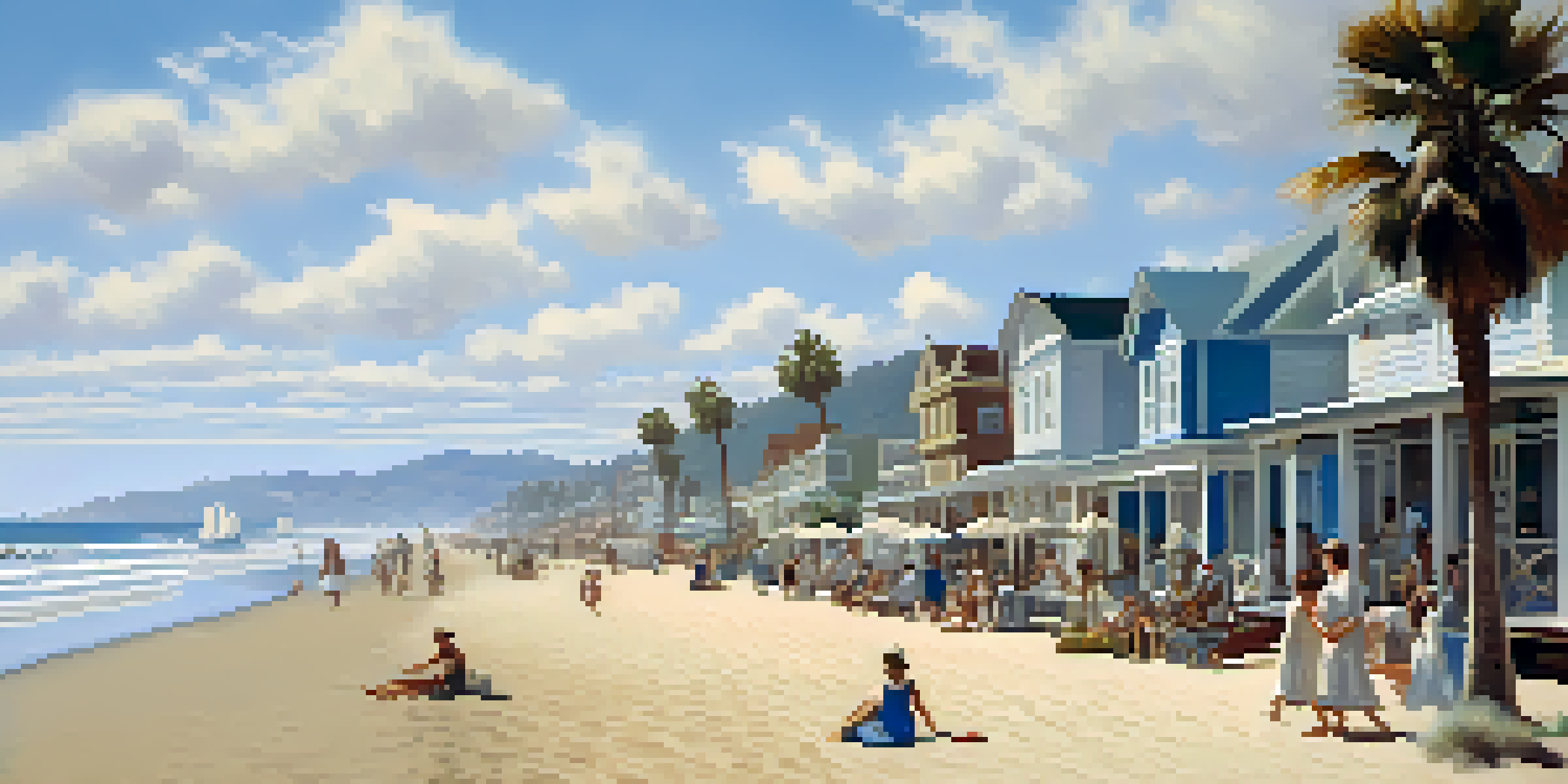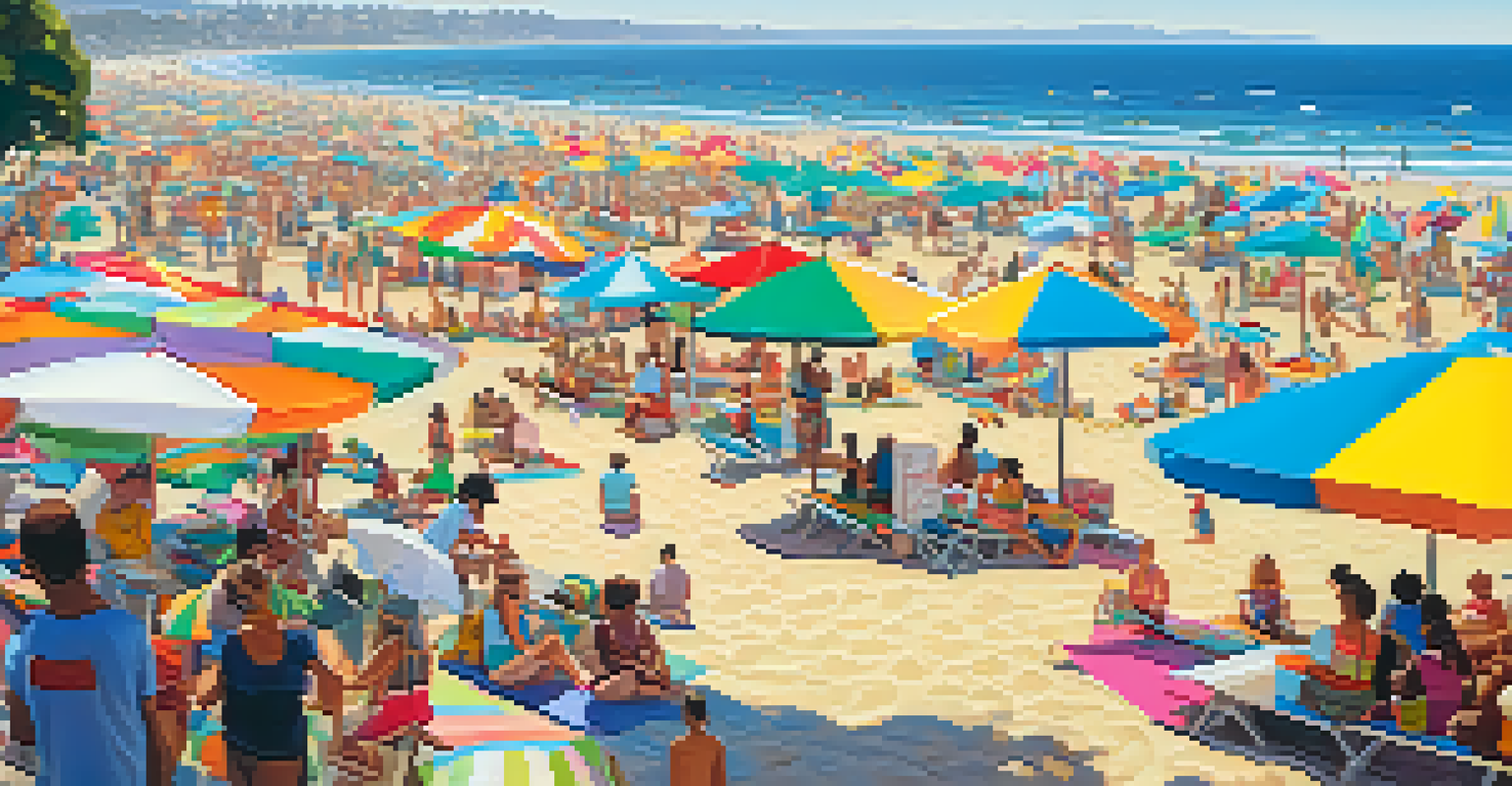The Evolution of Beach Culture in Santa Monica Over the Decades

The Early Days: Santa Monica Beach in the 1900s
In the early 1900s, Santa Monica Beach was a quiet escape for locals and visitors alike. The shoreline was dotted with small cottages and simple piers, creating a laid-back atmosphere that drew families seeking relaxation. Swimming was a popular pastime, though many were cautious of the ocean’s depths, preferring the safety of the shore.
The ocean stirs the heart, inspires the imagination, and brings eternal joy to the soul.
The beach was also a hub for early amusement parks, with attractions like the iconic Santa Monica Pier drawing crowds. People flocked to the pier for its rides and games, marking the beginning of a vibrant beach culture. This era showcased a simpler time, where the ocean was both a playground and a serene retreat.
As the beach grew in popularity, it began to attract a more diverse crowd. The local community thrived on the unique blend of cultures, setting the stage for Santa Monica's evolution into a beach destination that would attract people from all walks of life.
The Roaring Twenties: Glamour and Surfers Unite
The 1920s brought a wave of glamour to Santa Monica Beach, with beachgoers donning stylish swimsuits that were the latest fashion. This era saw the rise of beach clubs and social events, as people embraced the sun, sand, and surf. The beach became a hotspot for the wealthy, further transforming the cultural landscape.

Simultaneously, the surf culture began to emerge, with surfers taking to the waves on wooden boards. The thrill of riding the ocean's swells captivated many, creating a unique subculture that celebrated freedom and adventure. This blend of glamour and surf culture laid the foundation for what Santa Monica would become in the decades to follow.
Santa Monica's Evolving Beach Culture
Over the decades, Santa Monica Beach has transformed from a quiet escape to a vibrant, diverse destination that embraces various cultures and lifestyles.
As the beach attracted more visitors, it also became a canvas for artistic expression. Musicians and artists flocked to the area, contributing to a rich tapestry of creativity that defined Santa Monica during this vibrant decade.
The Post-War Boom: Family Fun and Iconic Landmarks
After World War II, Santa Monica Beach experienced a boom in family-friendly activities. The local economy flourished as returning veterans and their families sought recreation and relaxation by the ocean. This period saw the construction of iconic landmarks, like the restored Santa Monica Pier, which became a beloved gathering place.
The beach is not just a place; it’s a feeling, an experience that brings people together.
The beach began to cater to families with children, offering everything from carnival games to picnic areas. The sense of community thrived as families created lasting memories in the sun. This marked a shift toward a more inclusive beach culture that welcomed people of all ages.
As beach culture evolved, so did the events held on the sand. From sandcastle competitions to summer concerts, Santa Monica Beach became a lively venue for celebrations that brought the community together, reinforcing its status as a premier destination.
The 1970s and 1980s: Counterculture and Environmentalism
The 1970s ushered in a wave of counterculture at Santa Monica Beach, as surfers, artists, and activists flocked to the area. This era was characterized by a growing awareness of environmental issues, leading to movements aimed at preserving the natural beauty of the coastline. The beach became a gathering place for those advocating for ecological change.
During this time, the surf culture expanded, with the introduction of new surfboards and techniques. Surfing competitions began to gain popularity, attracting talent from all over California. The vibrant energy of the beach was palpable, as it served as a backdrop for both self-expression and community activism.
Health and Wellness Focus Emerges
In the 2000s, the beach became a hub for health and wellness, promoting outdoor activities and community events that fostered connection and sustainability.
As the community became more engaged in environmental efforts, initiatives to clean up the beach and protect marine life were established. This commitment to sustainability became a hallmark of Santa Monica’s beach culture, influencing generations to come.
The 1990s: Gentrification and a New Wave of Visitors
The 1990s marked a period of gentrification in Santa Monica, as upscale shops and restaurants began to emerge along the beachfront. With this transformation came an influx of tourists eager to experience the newfound charm of the area. The beach evolved into a trendy destination where luxury and leisure coexisted.
While the beach still offered its classic appeal, the rising property values and commercial development changed the landscape. Visitors now had access to a variety of dining and shopping options, catering to a more affluent clientele. This shift also introduced new experiences, like yoga on the beach and gourmet food trucks.
Despite the changes, the essence of Santa Monica Beach remained intact. Locals and tourists alike continued to enjoy the sun, surf, and sand, blending the old with the new to create a dynamic beach culture that celebrated its heritage while embracing modernity.
The 2000s: Health, Wellness, and Community Events
As the new millennium arrived, Santa Monica Beach became synonymous with health and wellness. The beach was no longer just a place to lounge; it transformed into a lifestyle hub where fitness enthusiasts engaged in outdoor activities like beach volleyball, running, and yoga. This shift promoted a culture centered around well-being and vitality.
Community events flourished, with farmers' markets, outdoor concerts, and beach clean-ups becoming staples of the local calendar. These events fostered a sense of community, encouraging residents and visitors to come together and celebrate the environment. The beach was more than just a recreational space; it became a venue for connection and collaboration.
Commitment to Inclusivity and Sustainability
Today, Santa Monica Beach prioritizes inclusivity and environmental initiatives, ensuring that everyone can enjoy its beauty while protecting its natural resources.
The focus on health and sustainability also influenced local businesses, with many establishments prioritizing organic and locally sourced products. This commitment to wellness and community engagement further solidified Santa Monica's reputation as a progressive beach culture.
Present Day: A Diverse and Inclusive Beach Culture
Today, Santa Monica Beach boasts a diverse and inclusive culture that represents a wide range of backgrounds and experiences. The beach is a melting pot where people from different walks of life come together to enjoy the sun, surf, and sand. Festivals celebrating various cultures and communities are held throughout the year, enhancing the vibrant atmosphere.
The local government and organizations continue to prioritize sustainability, implementing initiatives to protect the environment. Efforts to promote accessibility ensure that everyone can enjoy the beach experience, regardless of their abilities. This commitment to inclusivity reflects Santa Monica's values and reinforces its standing as a welcoming destination.

As we look to the future, Santa Monica Beach remains a symbol of evolution—a place where history, culture, and community converge. The beach continues to adapt to the changing times while honoring its rich legacy, ensuring it remains a cherished destination for generations to come.